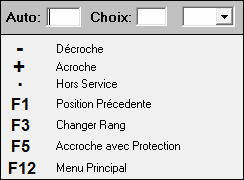De Base de connaissances Fraxion
Sauter à la navigation
Sauter à la recherche
| The car's position table is the module that allows you to see at a glance the distribution of the fleet of vehicles within the zones, but also their rank, the type of vehicle, the ones that are protected and the ones that are in penalties. It is also in this module that a dispatcher can hook, unhook, change the rank, put out of service or protect a vehicle in a zone
|
Color Code
- Vehicles displayed in black are normal vehicles that are hung in a zone.
- Vehicles displayed in blue are protected vehicles.
- Vehicles displayed in light gray are vehicles that are hung on a post from1.
- Vehicles displayed with a red bar in front of the number means it is a van.
Operation of the controls
At the bottom right of the hitching board, there is a box with fields, intended to force an action if needed.
- Pick up a vehicle
- In the box "Auto", enter the number of the car and the
- key (subtraction sign). Unhooking a vehicle may be necessary when the vehicle is protected in the wrong area, when the driver is not in the car and forgot to turn it off, etc.
- Hook a vehicle
- In the "Auto" box, enter the car number and the
+ key (addition sign). Docking a vehicle may be necessary when ?
- Take a vehicle out of service
- In the "Auto" box, enter the car number and the
. (period) key. Taking a vehicle out of service may be necessary when ?
- Restore a vehicle to its previous position
- In the "Auto" box, enter the car number and the
F1 key. Restoring a vehicle to its previous position may be necessary when ?
- Change the rank of a car
- In the "Auto" box enter the car number, in the "Choice" box enter the desired position and press
F3. Changing the rank of a car may be necessary when...
Notes
Modèle:References
|
- ↑ Note that this may differ from company to company, depending on regulations and internal operating procedures.
